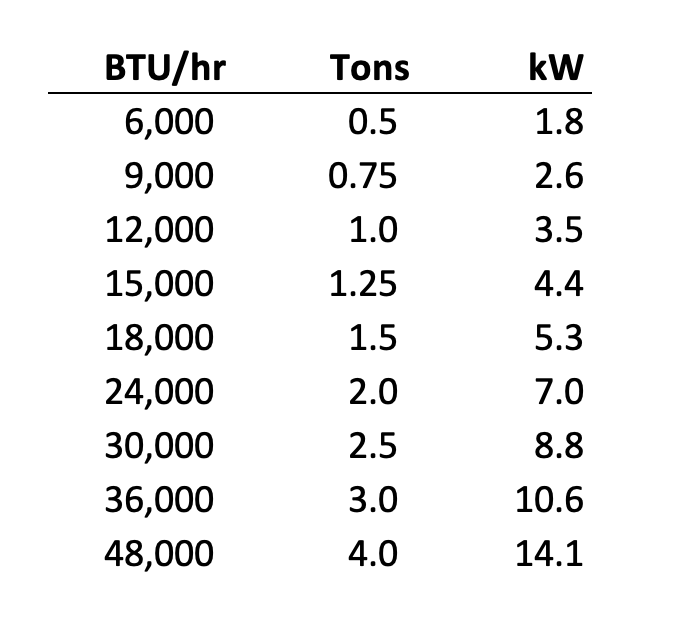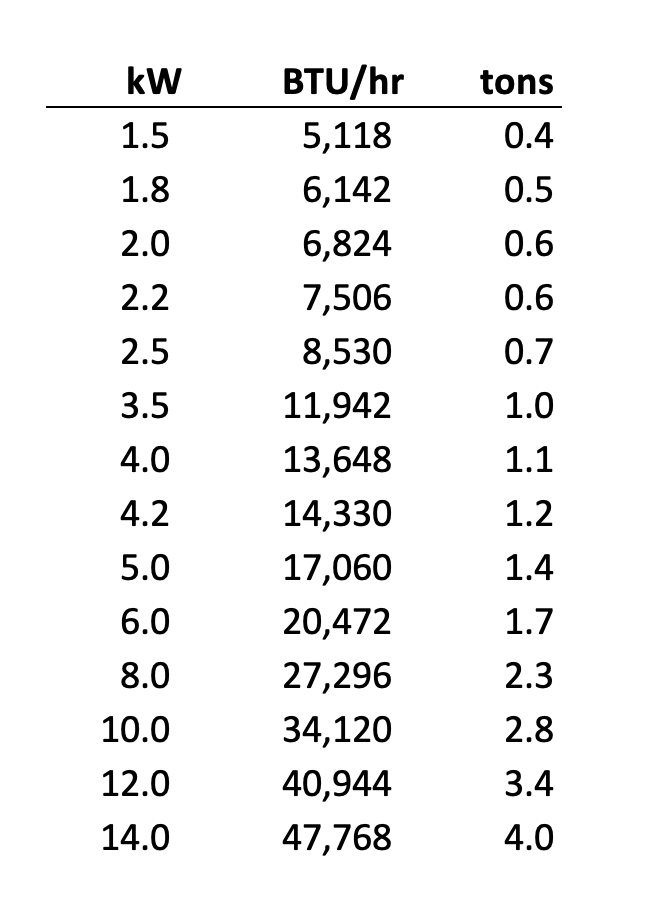
Heat pumps are riding a wave of demand and curiosity lately. With all the talk of electrification and decarbonization, heat pumps are in! We specify heat pumps in most of our HVAC design jobs at Energy Vanguard. We’ve got them in our office, and I have them in my house. But this isn’t just a U.S. or North America thing. They’re big in many parts of the world. So, let’s talk about converting heat pump capacity between English and metric units.
The old units
Here in the U.S., we’re still on the obnoxious, antiquated, annoying system of units developed in the time when humans had either 12 or 16 fingers instead of the current 10.* As a result, those old units have 12 inches per foot and 16 ounces per pound. They go by various names, with English, inch-pound, imperial, and U.S. customary being the most common. There are some differences among them, but I’m just going to call them English here.
The problem with using the old units is that the rest of the world does things differently. They don’t use British Thermal Units per hour (BTU/hr). They use kilowatts (kW) instead. Now, we use kilowatts in the U.S., but only when we’re talking about electricity. That’s good because we have some familiarity with that metric unit. But that’s bad for another reason, which I’ll get into below.
Converting English units to metric
When we talk about the capacity of a heat pump here in the U.S. and Canada, we use BTU per hour as the unit. Sometimes we use the ton, which is an easy conversion. One ton of heating or cooling capacity is just 12,000 BTU/hr. The ton was invented for cooling because it has its origin in the weight of ice.
Converting heat pump capacity to kilowatts is easy. You simply divide the capacity in BTU/hr by 3,412. That’s because there are 3,412 BTU/hr in one kW. It’s just a conversion factor, so nothing to be afraid of.

The table above shows common capacities you can find for heat pumps in the U.S. and Canada. They range from 6,000 to 48,000 BTU/hr. The second column shows the equivalents in tons, and the third column shows the capacities in kilowatts. Easy peasy, right? One thing to note here is that conventional heat pumps start at 18,000 BTU/hr. To go lower, you need a minisplit heat pump.
Oh, in case you’re wondering why I didn’t include 60,000 BTU/hr (5 tons, 17.6 kW), we have a saying in our office when working on designs: 5 tons is never the right answer. It’s just too difficult to make a 5 ton system keep one house comfortable, but that’s a different article.
Converting the other way
But what if you’re looking at a heat pump in the United Kingdom rated in kilowatts and are wondering how many BTU per hour or tons it equates to? You can always use the conversion factors above to do the calculation, of course. The table below, though, shows you the range of capacities for various UK heat pumps and their equivalent capacities in our annoying units.

One big takeaway from the two tables above is the ranges. In the U.S. and Canada, our heat pumps go from 0.5 ton to 4 tons (OK, yeah 5 tons, but that’s the wrong answer). That range runs from about 2 kW to 14 kW in metric capacities. And the metric-to-English conversion shows about the same: 1.5 to 14 kW corresponds to 0.4 to 4 tons.
Don’t make this mistake
All the numbers I discussed above refer to the amount of heat moved by a heat pump. Don’t confuse that with the amount of electricity used by the heat pump. That’s the pitfall I referred to above since we use kilowatts only for electricity in the U.S. A 1-ton heat pump moves 12,000 BTU of heat per hour, or 3.5 kilowatts.
The amount of electrical power needed, however, is generally only about a third of the amount of heat moved. Remember, a heat pump isn’t generating heat, as a furnace does. It’s just moving heat. You can think of a heat pump as a kind of lever or pulley system. For example, you can lift a 500-pound weight with only 50 pounds of force when you use a block-and-tackle. That’s kind of what a heat pump does for you, too. You do a small amount of work to move a much larger amount of heat.
Not just for heat pumps
I’ve focused on heat pumps here, but the conversions above apply just as well to air conditioners, furnaces, boilers, or anything else with a power rating. All we’re doing above is converting heat pump capacity from one type of unit to another.
* Of course it isn’t true that humans used to have 12 or 16 fingers. Despite what you might see in those ancient statues and paintings, it’s always been ten.
_________________________________________________________________________
Allison A. Bailes III, PhD is a speaker, writer, building science consultant, and the founder of Energy Vanguard in Decatur, Georgia. He has a doctorate in physics and writes the Energy Vanguard Blog. He also has a book on building science coming out in the fall of 2022. You can follow him on Twitter at @EnergyVanguard. Photos courtesy of author.
Weekly Newsletter
Get building science and energy efficiency advice, plus special offers, in your inbox.















6 Comments
"They don’t use British Thermal Units (BTUs). They use kilowatts (kW) instead."
The corresponding term for BTU is kWh. Both are units of energy. kW is akin to BTU/h, terms of power (amount of energy per unit time).
kWh hour is not really a proper metric unit, as the metric unit for energy is the Joule (J), which is conveniently both 1 Watt per second and 1 newton-metre. This unit is almost never used outside of science labs, since it's such a small amount and doesn't scale in a nice, relatable way like kWh does. It's very easy to see that a 1kW heater running all day will be 24kWh, and vice versa, much less easy to imagine what 86,400,000J (or 86.4MJ) represents. Too bad we never decimalized time (e.g. 100 seconds in a minute, 100 minutes in an hour, 10 hours in a day), as we could have avoided this inconvenience.
Trevor: Thanks for pointing out my little mistake. Since I was talking about the power ratings for heat pumps, I meant to write BTU/hr there and have corrected the text above.
I'm interested in why 5 ton is never the answer? During frustrations building my house the numbers showed I needed something like 2.5 ton for cooling. My HVAC guy said he never puts anything less than a 5 ton in a house of my size but he wasn't really understanding the thermal envelope and heat loss. I'm pretty sure he installed a 5 ton air handler (I'll double check the specs) and it's loud due to the excessive velocity in the duct works and it short cycles all the time. I'm pretty annoyed with myself for letting that happen.
I've been looking for a simple explanation like this. The only way this could be better is if you showed an example of the physical devices for the indoor and outdoor units or parts
GreenBuildingAdvisor: https://www.greenbuildingadvisor.com/article/sizing-a-heat-pump-system-for-cooling uno online
“[Deleted]”
Really how heat pump capacity convert btu/hr into ton and kW is surely simple I didn’t know it could be this easy until the moment I uttered the 3,412 for btu-kw. That’s just for the basic understanding, if offers a complete and total overhaul to what you thought you knew about HVAC. check out;
https://www.emucoupon.com/code/thelashrehab
Log in or create an account to post a comment.
Sign up Log in